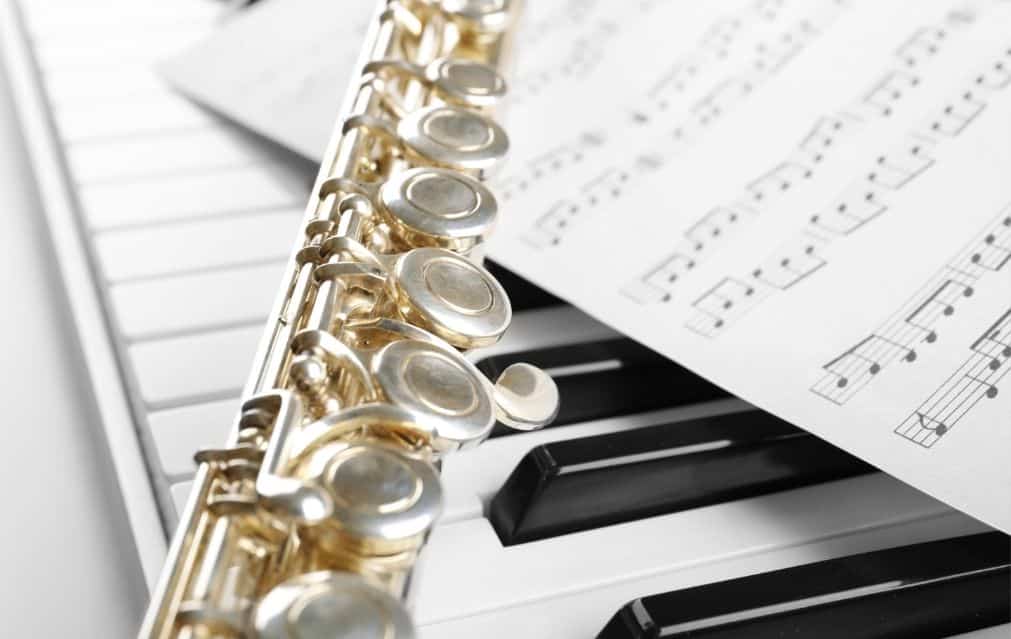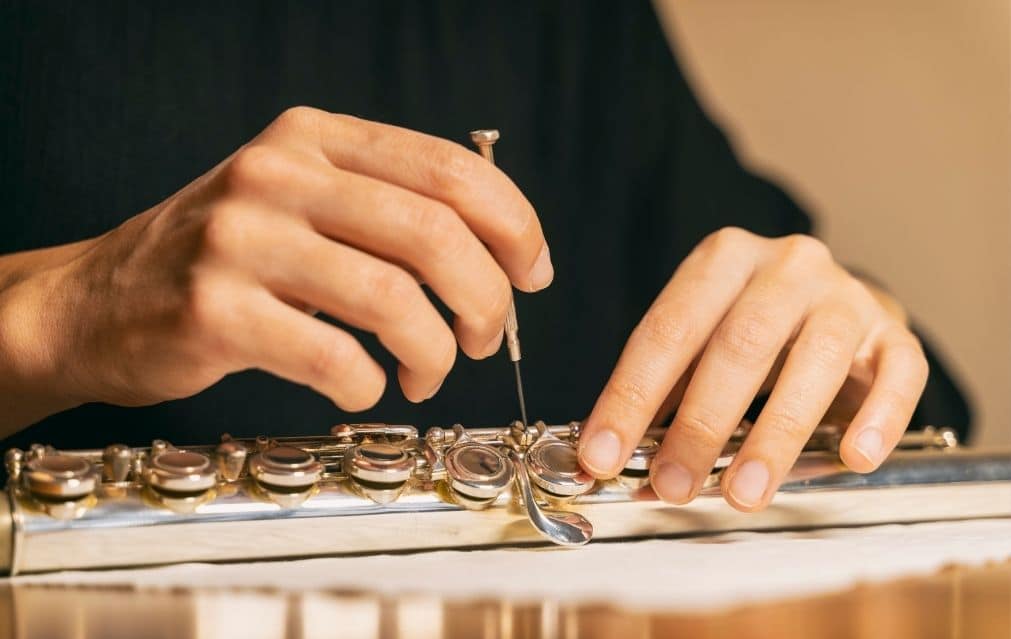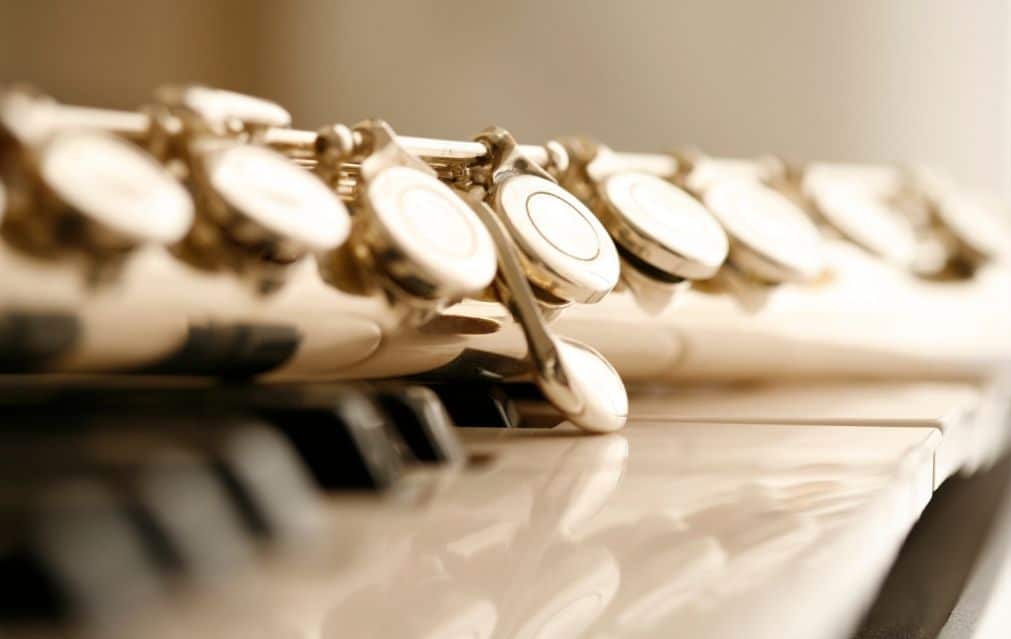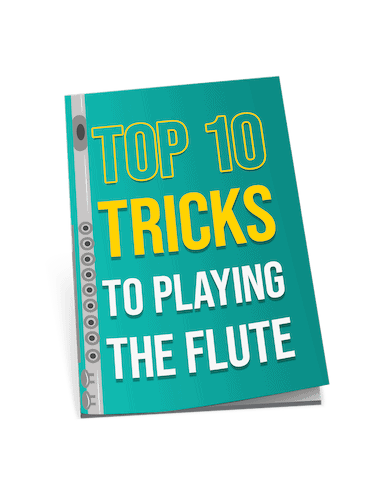Best
Flute For Beginner
-
Overall: With Genesis head joint
-
Best Feature: Upgraded mouthpiece with a wide riser angle
-
TedScore™: 8/10
Best
Overall Flute
-
Overall: A durable body that can last for years
-
Best Feature: It can handle almost anything you put it through
-
TedScore™: 8/10
Best
Budget-friendly
Flute
-
Overall: Closed-hole flute - easier for beginner
-
Best Feature: Nickel Silver Body
-
TedScore™: X/10

When it comes to discovering the best flute brands for students, a few stand out for their quality and durability—so many delightful options, but which one won’t leave you feeling off-key?
From Yamaha’s robust build to Pearl’s fine craftsmanship, we’ll explore what makes each of these instruments shine, like a conductor guiding an orchestra.
Remember, understanding the top brands can make all the difference in your musical journey.
Recommended Flute Brands for Students

Exploring flutes for students can be a delightful journey. With several options designed for beginners, it’s essential to focus on flutes that offer durability, sound quality, and ease of playability for those just starting their musical voyage.
Yamaha
The Yamaha YFL-222 is often my top pick for beginners. Crafted with durable nickel silver and a silver-plated finish, it showcases an elegant design.
This model, featuring a responsive key mechanism, offers ease of play, making it a hit amongst novices. It includes a light tone, perfect for those developing their skills.
I find the Yamaha flute to be well-engineered and have a reputation for consistency. They’re built to withstand the test of time, providing continual support during years of practice.
Yamaha YFL222

DESIGNED FOR: new players looking for a good flute
FEATURES: a durable body that can last for years
OTHER INFO: it can handle almost anything you put it through
Yamaha YFL222
- Nickel silver with silver plating
- Good price
- Easy to play
- Nice response
- No split E
- Not for young children
When you click ‘Check Price’, you’ll see there are loads of great places to buy this item. Our personal favorite is Sweetwater for the US, and Thomann and Gear4Music for the UK & Europe.
They are the largest music retailers, with excellent customer service, competitive prices, really fast shipping, and the longest guarantees.
The professional musician who wrote this article combined many things,
from the product build, manufacturer’s reputation through to feedback
from other users, to create our famous TedScore™.
Stagg
Stagg FL111 Flute has a solid construction and ease of play, which are the hallmarks here—one look at the instruments, and it’s clear they’re built to last. Plus, the brand’s commitment to producing consistently high-quality flutes builds quite the confidence in young flutists.
Stagg FL111 Flute

FEATURES: Closed-hole flute - easier for beginner
OTHER INFO: Nickel Silver Body
- Cost-effective
- Offset G for extra ergonomic design
- It may not be as durable as advanced flute
When you click ‘Check Price’, you’ll see there are loads of great places to buy this item. Our personal favorite is Sweetwater for the US, and Thomann and Gear4Music for the UK & Europe.
They are the largest music retailers, with excellent customer service, competitive prices, really fast shipping, and the longest guarantees.
The professional musician who wrote this article combined many things,
from the product build, manufacturer’s reputation through to feedback
from other users, to create our famous TedScore™.
Jupiter
The Jupiter JFL700REC Flute balances affordability and quality, which is easy. These instruments frequently feature snug keys that fit naturally under the fingers, and the responsive head joints craft a pleasing tone that can ignite any beginner’s passion for music.
Jupiter JFL700REC Flute

FEATURES: With Genesis head joint
OTHER INFO: Upgraded mouthpiece with a wide riser angle
- Includes a French case and cover so you're ready to travel
- Maintenance Needs
When you click ‘Check Price’, you’ll see there are loads of great places to buy this item. Our personal favorite is Sweetwater for the US, and Thomann and Gear4Music for the UK & Europe.
They are the largest music retailers, with excellent customer service, competitive prices, really fast shipping, and the longest guarantees.
The professional musician who wrote this article combined many things,
from the product build, manufacturer’s reputation through to feedback
from other users, to create our famous TedScore™.
Pearl
Pearl flutes are like reliable friends you can always count on. Their charm combines durability with a stunning tone, making them a top pick for intermediate flutists.
My experiences with the Pearl 505RBE1RB Quantz Series flute tell me it’s a choice that won’t disappoint, with features like pinless mechanisms and French pointed arms.
Pearl Flutes 505RBE1RB Intermediate Flute

FEATURES: Traditional craftsmanship combined with modern innovation.
OTHER INFO: Silver-plated head joint, body, and foot joint.
- Hand-assembled silver-plated keys are effortless to play.
- Comfortable offset G key system with French-style open keys and split E mechanism.
- It Includes a French case with a cover, cleaning cloth, cleaning rod, and polishing cloth.
- It may offer limited customization options compared to other intermediate flutes.
When you click ‘Check Price’, you’ll see there are loads of great places to buy this item. Our personal favorite is Sweetwater for the US, and Thomann and Gear4Music for the UK & Europe.
They are the largest music retailers, with excellent customer service, competitive prices, really fast shipping, and the longest guarantees.
The professional musician who wrote this article combined many things,
from the product build, manufacturer’s reputation through to feedback
from other users, to create our famous TedScore™.
Advancing with Professional Flutes

Professional flutes enhance sound quality and craftsmanship. Transitioning from student flutes involves exploring features such as solid silver components and advanced key mechanisms, with top brands offering high-quality instruments.
Transitioning from Student to Professional Flutes
Moving from a beginner flutes to an intermediate and advanced flutes is like upgrading from a bicycle to a sports car.
There’s a noticeable improvement in sound quality, particularly with flutes featuring a solid silver head joint. This elevates the richness of the tone.
The addition of a B foot joint extends the lower range, letting me explore more complex pieces with ease.
Understanding Flute Basics

When choosing the right flute, it’s important to know the different types available, their components, and the materials used in their construction. This knowledge helps in selecting a quality instrument that suits one’s needs and skill level.
Types of Flutes
Flutes come in various types, each with unique characteristics that cater to different players. The concert flute, the most common type, is often what students start with.
The piccolo is smaller and plays higher notes, adding a bright touch to any band or orchestra. For those looking to explore deeper tones, the alto and bass flutes are perfect choices.
These flutes are often used in ensembles and require a bit more breath control due to their larger size.
Anatomy of a Flute
The flute’s structure is fascinating and crucial for producing good sound. Key parts include the head joint, body, and foot joint. The curved head joint can help younger players by bringing the keys closer together.
Flutes can have either a C foot joint or a B foot joint, with the latter offering an extended range. Flute keys come in closed-hole or open-hole configurations.
The offset G key , a feature frequently found in student models, serves a specific purpose. It provides a more comfortable hand position, which is crucial for beginners as they learn to play the flute.
Flute Materials and Design
Material choice impacts tone quality and durability.
- Silver-plated flutes are common among students for their bright sound and affordability.
- Nickel silver flutes are durable, resisting scratches and dents, and are perfect for regular use.
Design features, like the arrangement of keys and the presence of an offset G, are essential considerations when choosing a flute. The alignment of the flute’s components contributes to playability, making it easier to maintain proper technique.
Choosing the right flute involves balancing these elements to find a perfect match for one’s musical journey.
Learning Curve, Accessories and Maintenance

Accessories like a good flute stand, and proper cleaning tools ensure your flute stays in top condition. Meanwhile, regular maintenance not only improves sound quality but also prolongs the life of the instrument.
Navigating with Flute Lesson
When learning to play the flute, it’s essential to find a skilled flute teacher who can guide you through proper technique and help you develop your flute playing skills.
Many professional flute players emphasize the importance of consistent practice and dedication to achieving a high level of flute performance. Aspiring flutists should also take the opportunity to watch live flute performances by experienced musicians, as this can provide valuable insight and inspiration for their flute playing journey.
With the right guidance, practice, and exposure to professional flute players, anyone can work towards mastering the art of flute playing.
Caring for Your Flute
Taking care of a flute requires regular cleaning.
I always use a cleaning rod and cloth to remove moisture after playing. It’s like giving your flute a nice little polish, which helps in avoiding any pesky rusting or tarnishing.
Keep your flute in its case when not playing. This prevents accidental damage.
Must-have Flute Accessories
Flute stands are not just underrated; they’re essential. They keep your flute safe and ready to play at a moment’s notice, providing a sense of security and peace of mind.
I use one with a stable base to prevent any unexpected wobbles or falls. A closed-hole flute might come with plugs, and it’s always handy to carry a few spares in case of emergencies.
When it comes to quirky but vital accessories, a carefully selected cleaning swab is a must-have. It acts like a bath towel for your flute to keep it dry and in top condition.
The Final Note:
Top Flute Brands for Musicians

Picking out a flute was like finding my very own magic instrument in the world of music—it was like the flute picked me as much as I liked it. This made me see that certain flutes click with beginners.
The Yamaha YF-222 won me over with its charm, while the Stagg FL111 stood out as the best budget-friendly option for those of us watching our cash.
Who could miss the cool Jupiter JFL700REC with its fancy silver lip plate? Plus, the Pearl 505EUS Quantz Flute felt like a fun surprise, with a bright and lively sound.
To wrap up our discussion, here’s a handy summary:
- Top Pick: Yamaha YF-222
- Runner Up for Beginner Students: Jupiter JFL700REC
- Best Budget: Stagg FL111
Starting your musical journey is super exciting, and I hope my quick look at these flutes gives you some helpful ideas. Your choice leads to a great time learning and playing music.
Hold up, we’re not finished yet…
If you’re a beginner flutist looking to steer clear of subpar instruments, be sure to check out our eye-opening article, “Flute Brands To Avoid,” and make an informed decision when selecting cheap flutes or your first flute.
FAQ's
Yamaha, Pearl, and Jupiter are the best flute brands for students, as they offer high-quality instruments at reasonable prices. Ultimately, the best choice will depend on the individual student’s needs, preferences, and budget.
Yamaha is widely regarded as one of the best flute brands, known for their exceptional craftsmanship, durability, and tonal quality across all skill levels. Other top brands include Pearl, Muramatsu, Miyazawa, and Powell, each offering a range of high-quality flutes suitable for students, intermediate players, and professionals.
For beginners, a closed-hole, offset G flute made from nickel-silver or silver-plated material is often recommended. These flutes are typically more affordable, easier to play, and more durable than their open-hole or solid silver counterparts, making them ideal for students who are just starting their musical journey.
When choosing a student flute, consider factors such as budget, brand reputation, materials (e.g., nickel-silver or silver-plated), and features like offset G and closed-hole keys for easier playability. It’s also essential to consult with a music teacher or professional and try out several flutes to find the one that feels most comfortable and produces the best sound for the student.











Hey Robert Emery, great rundown on student flutes! I’m just getting into the flute myself and weighing my options. The brands you listed are super helpful, but I’m a bit torn between Yamaha and Pearl. Yamaha’s reputation is stellar, but I’ve heard some really good things about Pearl’s sound quality too. In your opinion, based on a newbie’s needs for sound quality and ease of learning, which one would you lean towards for a first flute? Budget is a bit flexible if it means getting an instrument that’ll grow with me for a bit. Thanks!
Hey EmmaL89, not Robert, but I’ve taught flute for years. Honestly, both brands are solid. Yamaha tends to be more forgiving for beginners and has a very reliable build quality. Pearl has a unique sound that some prefer as you advance. If possible, try both and see which one feels better for you. Nothing beats firsthand experience.
Haha, looks like I stumbled into the wrong section! Thought this was about the mighty tuba. Flutes are cool and all, but can they really provide that oomph like a tuba? Guess you guys are all about those high notes.